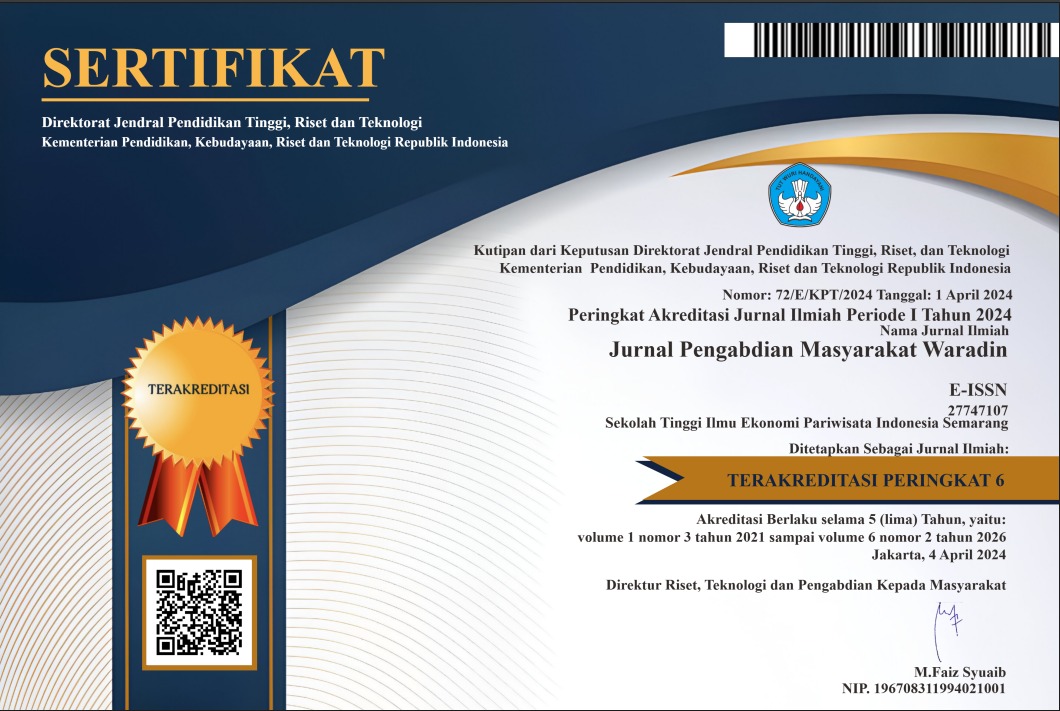Inovasi Sistem Filtrasi dengan Substrat Filter Fisik dan Kimia untuk Budidaya Ikan Air Tawar di Kolam
DOI:
https://doi.org/10.56910/wrd.v5i1.398Keywords:
Filterization tools, Physical and Chemical Filter Substrates, CirculationAbstract
Water is one of the things that is important for life, it is even more important if the water that is obtained can provide other benefits. This is the case for freshwater fish breeders in the Kemuning tributary of the North Banjarbaru River, South Kalimantan. Water is an important variable because water is the medium where fish live. Freshwater fish of good quality are a superior commodity for fisheries cultivation in Indonesia in general. This aquatic organism is the same as freshwater fish in general which breathe using gills (operculum). The treatment of the freshwater fish cultivation process requires a flowing water media system with sufficient oxygen content. For this reason, several tools are needed to maintain the quality of pool water, namely a pool water filter (filter), a water suction and spray tool to regulate water circulation and an aerator to produce air bubbles. In this service activity, a water filter will be made with physical and chemical substrates to filter pond water with a water circulation system so that the filtered water has good water quality to support the life cycle of freshwater fish. As power to run the supporting equipment in the water filtering system, electricity is used by utilizing sunlight using solar cells. In this community service activity, to overcome existing problems, a pool water filter will be made with physical and chemical substrates. Making freshwater fish pond water filters using Bioring, Charcoal, Japmate, and Bio Foam substrates, where these 4 substrates provide good water quality results, namely, temperature 28.1–30.30C, pH7.4–8.1, DO 5.246 .53mg/L, NH 30.06–0.40mg/L, NO2 0.056–0.90mg/L and NO3-0.28–0.190 mg/L, the highest survival test (SR) in the bioring treatment was 86, 66%, the feed conversion ratio (FCR) test yielded a result of 3.10%. Meanwhile, the specific growth rate (SGR) test for freshwater fish was found to be 1.15%. However, of course, the more important target is to provide knowledge about good freshwater fish cultivation for residents of the Kemuning tributary, Loktabat Utara Banjarbaru Village, with an increase in knowledge of approximately 85% from before the PPM activities. The main output of this activity is an accredited Community Service Journal, in addition to water filtering equipment products with physical and chemical filter substrates.
References
Ahmed, N., & Turchini, G. M. (2021). Recirculating aquaculture systems (RAS): Environmental solution and climate change adaptation. Journal of Cleaner Production, 297, Article 126604. https://doi.org/10.1016/j.jclepro.2021.126604
Badiola, M., Mendiola, D., & Bostock, J. (2012). Recirculating aquaculture systems (RAS) analysis: Main issues on management and future challenges. Aquacultural Engineering, 51, 26–35. https://doi.org/10.1016/j.aquaeng.2012.07.004
Candra, H. K., Cahyani, R. F., Noor, S., Bahit, M., & Mulyani, D. (2022). PPM penerapan biofilter pada air kolam budidaya ikan nila di aliran sungai kemuning Banjarbaru Kalimantan Selatan. J-MAS: Jurnal Pengabdian Masyarakat, 1(3), Article 3. https://doi.org/10.59004/jmas.v1i3.145
Candra, H. K., Noor, S., Bahit, M., & Mulyani, D. (2024). Prediction of freshwater fish pond water quality levels using the backpropagation method based on the Internet of Things (IoT). International Journal of Science, Technology & Management, 5(5), Article 5. https://doi.org/10.46729/ijstm.v5i5.1140
Chauhan, R. S., & Mishra, A. (2023). New innovative technologies for sustainable aqua production. In Biodiversity. CRC Press.
Eding, E. H., Kamstra, A., Verreth, J. A. J., Huisman, E. A., & Klapwijk, A. (2006). Design and operation of nitrifying trickling filters in recirculating aquaculture: A review. Aquacultural Engineering, 34(3), 234–260. https://doi.org/10.1016/j.aquaeng.2005.09.007
Lindholm-Lehto, P. (2023). Water quality monitoring in recirculating aquaculture systems. Aquaculture, Fish and Fisheries, 3(2), 113–131. https://doi.org/10.1002/aff2.102
Molden, D., Oweis, T., Steduto, P., Bindraban, P., Hanjra, M. A., & Kijne, J. (2010). Improving agricultural water productivity: Between optimism and caution. Agricultural Water Management, 97(4), 528–535. https://doi.org/10.1016/j.agwat.2009.03.023
Sarker, N. K., & Salam, P. A. (2020). Design of batch algal cultivation systems and ranking of the design parameters. Energy, Ecology and Environment, 5(3), 196–210. https://doi.org/10.1007/s40974-020-00149-3
Xiao, R., Wei, Y., An, D., Li, D., Ta, X., Wu, Y., & Ren, Q. (2019). A review on the research status and development trend of equipment in water treatment processes of recirculating aquaculture systems. Reviews in Aquaculture, 11(3), 863–895. https://doi.org/10.1111/raq.12270







